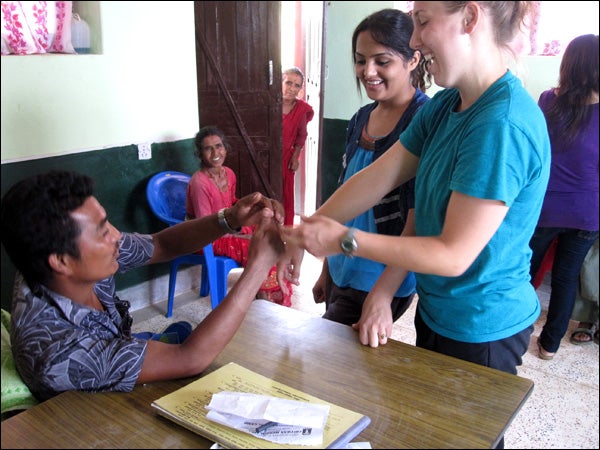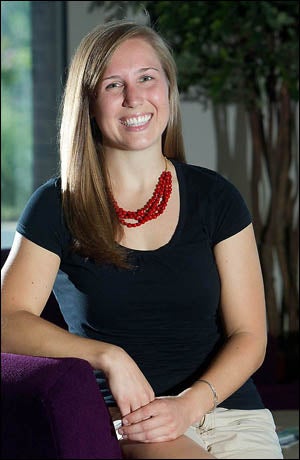SOLVING PROBLEMS
ECU physical therapy student gains unique perspective in Nepal

East Carolina University physical therapy student Kelsey Romoser, far right, worked with a patient at a rural health post during her assignment with 500-bed Chitwan Medical College Teaching Hospital in Bharatpur, Nepal. (Contributed photo).
Kelsey Romoser’s summer began half way around the world, working in a clinic in Nepal.
It was something the East Carolina University physical therapy student had wanted to do since starting graduate school, building on her undergraduate study abroad experience.
Although ECU physical therapy didn’t have a contract there, she researched and found Projects Abroad, an organization that sends students in medicine, dentistry and nursing to clinical assignments overseas.
If they worked with those students, she thought they might accept a physical therapy student, too.
Dr. Patricia Hodson, clinical professor and director of clinical education in the ECU physical therapy department, said it is rare that students seek opportunities to complete courses in other countries. Some students have worked in Canada, the United Kingdom and Australia. The department has a contract with a center in Belize but so far no students have affiliated there.
Romoser’s motivation, maturity and previous travels helped her perform well outside her comfort zone, Hodson said.
“An experience abroad in an underserved county is highly beneficial in that students don’t have the luxury of a well-equipped clinic and must learn to be creative in order to problem-solve ways to help a patient accomplish functional goals with limited resources,” Hodson said.
Romoser had been in hospitals in India and China but never Nepal. “I could see myself going there and learning a lot,” she said. “The hospitals are very different than what we have here.”

Kelsey Romoser
(Photo by Cliff Hollis)
As a junior at N.C. State University, she participated in “Semester at Sea,” a program where 650 students from across the United States lived on a ship, stopping at a different port for five days. “You’d be talking about things in class one day, and going out and seeing it and experiencing it the next day,” she said.
She earned a bachelor’s degree in psychology and is now in her third year at ECU, with plans to graduate with a doctoral degree next spring.
Romoser arrived in Bharatpur on May 7, where she stayed with a host family and another volunteer, and returned home July 4.
She saw patients at Chitwan Medical College Teaching Hospital, a 509-bed hospital and outpatient center. The hospital had two physical therapists on staff. “That’s generally what they have, so they are short-staffed,” she said. “We were busy.”
Most people saw a doctor only for emergencies or accidents because they couldn’t afford routine health care. Some patients would receive physical therapy in the hospital but many went home as soon as they were medically stable before getting directions on proper in-home rehabilitation.
Patients would only return for outpatient physical therapy if they couldn’t work or do daily activities. Those who returned to the hospital, sometimes from five to 14 months after discharge, had trouble.
“Trying to regain range of motion would be very challenging,” she said.
In Nepal, families are an important part of patient care. When Romoser provided treatment, it wasn’t unusual to have an audience of 20 people, who would ask questions and share in what was going on, she said.
“In the hospital, it is the family’s responsibility to get food for the patient, take the patient to the bathroom, get medications from the pharmacy and bring them to the room. If patients didn’t have medication, they didn’t get it until a family member got back,” she said.
“It’s very different from what we’re used to, but from the physical therapy perspective, it was great having the family involved, and to be that motivator when the therapist couldn’t be around.”
In the future, Romoser said she would like to incorporate family members in the care she provides to help patients stay motivated and accountable for their progression.
At the hospital and in her host home, power outages were a part of daily life. The hospital had a generator, but no air conditioning except in the operating room, radiology, neonatal and intensive care units. Fans were used in patient wards.
“It wasn’t necessarily a comfortable place to be,” she said. “It was 100 degrees there a lot of the time I was there.”
Things that are considered routine in the United States were not done, such as washing hands between patients or using scissors only once. “It made me greatly value and appreciate our health care practices,” she said.
Still, no one complained about how hot it was in the hospital. Farmers needed to return to their fields to provide food for their families. Children in dental wards getting their teeth pulled didn’t cry. “They are just very tough, very strong people,” Romoser said. “People there are so grateful to receive care.”
With limited resources for therapy, she helped a stroke patient by taking a piece of an old T-shirt and rolling the fabric around a spoon or pen to act as a gripper, so he could use it to practice eating or writing. She later gave him black beans to practice placing the beans on a paper grid to improve his fine motor skills before he was discharged.
That patient, a man in his early 40s with a young daughter, returned for a doctor’s visit before Romoser left, and she could see his progress. He walked in by himself, and stopped at the registration desk, where he used a pen to write his name.
“That was the best way to end my time there,” she said. “I did make a difference. It was very rewarding.”
Romoser said the clinical experience helped her think about what she does and doesn’t want to do in her own practice one day.
“It gives you a unique perspective and it gets you to think about things in a different way and to question why you’re doing something,” she said. “I learned to problem-solve and get creative with what I had.”